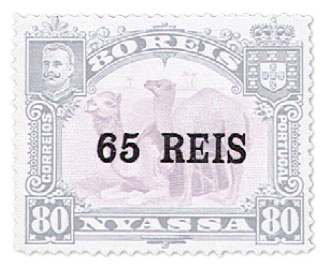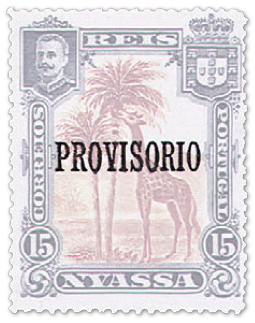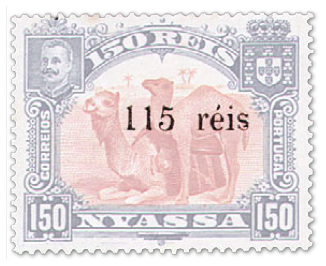
This article was written by Bertram W. H. Poole and first published in Mekeel’s Weekly Stamp News Feb 25, 1911 Volume XXV, Number 8, Whole Issue Number 1052.
The Portuguese colony of Nyassa is a large district of Mozambique in East Africa covering an area of about 100,000 square miles. It extends from the Indian Ocean to Lake Nyassa embracing littoral tracts 60 to 70 miles wide; a rolling plateau similar to the veld of South Africa; and a highland region, well-wooded, and divided into fertile and well-watered valleys. In common with British and German Nyasaland it receives its name from the great equatorial lake Nyassa which, it is interesting to note, was known to the Portuguese early in the 17th century (as Lake Maravi) though Dr. Livingstone was the first to fix its situation and navigate it in 1859.
Its philatelic history is short, being confined to a couple of provisional issues, which followed in rapid succession in 1897 and 1898, a pictorial set, placed on sale in 1901, a small crop of surcharges in 1903, and two more provisionals last year. Its story from a stamp-collector’s point of view would also have been uneventful but for the fact that the first attempt made at stamp issuing ended in a glorious fiasco.
An Unfortunate Issue
In 1894 a company known as the Nyassa Company, having on its Board of Directors an Ex-Minister of Marine, and as its Royal Commissioner an Ex-Minister of Public Works, was authorized by the Portuguese Government under Royal Decrees to administer and develop the territory of Nyassa. The company had extensive rights, including that of receiving all taxes and customs dues and of maintaining, working, and making all the means of communication in the country under its control.
Somewhat naturally it also considered it had the privilege of issuing its own postage stamps and accordingly a set was prepared almost as soon as the company had its offices in working order, apparently with the main idea of allowing stamp collectors to do their share in providing working capital. The labels are well described in the following caustic paragraph which appeared in the Monthly Journal for September, 1894 -:
A stamp-issuing company has been started here, which, judging from the appearance of its products, should be of a similar nature to the providers of other locals, and doubtless possesses the same philatelic capabilities. In the centre of the design is depicted what chess-players call a “rook,” perhaps a delicate allusion to the principal object of the issue; across this is printed the value; in curved labels at the sides are the words “COMPANHIA – DO NYASSA”, at the top “CABO – DELGADO,” at bottom “PROVINCIA – DE MOCAMBIQUE”. It will be seen that the company professes to do business over a very considerable area, but we fancy that its efforts will be for the most part confined to “Provincia Philatelica!”
The set consisted of 10, 20, and 50 reis values, both perf. and imperf. and the same values surcharged 5, 75, and 100 reis respectively, also perf. and imperf. The issue of “provisionals” before any of the stamps ever reached the place where they were to be used is pretty sure proof that the company had an “enterprising” philatelist on its staff. The governor of the company left England for Nyassa early in September, 1894, taking with him, it is said, a first parcel of stamps amounting in value to 158,737,000 reis. How many millions worth were left in London for sale to collectors history does not relate.
Whether any of these stamps were actually placed on sale for postal use or not is a point on which information is lacking but the issue received its quietus early in 1895. The Portuguese Government ordered the stamps to be suppressed, claiming that while the company was within its rights in having a separate issue it should have conformed to the internal regulations of the Mother Country by having the stamps printed and issued from the Royal Mint at Lisbon. The company either ignored or neglected this regulation by having the stamps prepared in London and they thus had to be withdrawn from circulation.
The First Issue
After the humiliating experience related above the company took no further steps to provide stamps for this territory until 1897. Evidently it was decided to treat the Portuguese Government with fitting respect and permission was asked and granted to issue a set of stamps. A Decree was published authorizing the company to have the then current stamps of Mozambique overprinted with the word “NYASSA” until a special die could be made to supply its requirements. The stamps so overprinted were the 1894 type of Mozambique, viz. :—
2 1/2 reis brown.
5r yellow.
10r reddish violet.
15r chocolate.
20r lavender.
25r green.
50r pale blue.
75r carmine.
80r yellow green.
100r brown on buff.
150r carmine on rose.
200r dark blue on blue.
300r dark blue on salmon.
Where the stamps were overprinted I have been unable to discover but it it seems probable the work was done at Lisbon. The 50 reis is known with inverted surcharge and, curiously enough, this error does not seem to have been discovered until late in 1900 – long after the stamps had become obsolete.
The Second Issue
No special effort seems to have been made to provide the “special die” referred to above and and when Mozambique was supplied with a new set of stamps in 1898 this series was likewise overprinted for use in Nyassa. The stamps were issued on August 1st and the set comprised the following values :—
2 1/2 reis grey.
5 ” orange yellow.
10 ” bright green.
15 ” brown.
20 ” gray violet.
25 ” blue green.
50 ” dark blue.
75 ” rose.
80 ” purple.
100 ” dark blue on blue.
150 ” brown on buff.
200 ” red lilac on pink.
300 ” dark blue on rose.
This set provides no varieties and, therefore, calls for no further comment.
The Third Issue
In 1900 the company again made representations to the Portuguese Government for permission to issue stamps of distinctive design. This permission was granted and the stamps were placed on sale on August 1st, 1901, as shown in the following Decree :—
Decree of the 12th June, 1901, published in the Diario do Governo, No. 132, dated the 17th June, 1901. GENERAL MINISTRY OF THE COLONIES. 2nd Department, 2nd Section.
Acceding to the representation made by the Nyassa company, H. M. the King has thought it desirable to authorise that company to put into circulation, in the territories of its concessions in Africa, from the 1st August next a new issue of postage stamps of the following values: 2 1/2, 5, 10, 15, 20, 25, 50, 75, 80, 100, 200 and 300 reis, approved by despatch of the 21st November, 1900.
The present stamps of the same values, which are those of the province of Mozambique, surcharged “Nyassa,” must continue in circulation, according to the Royal Decree of the 27th October, 1897, and are to be considered valid simultaneously with the new stamps until the 31st August, but they may be exchanged for stamps of the new issue until the 30th September next, according to paragraphs 3 and 4 of the postal regulations of 1892.
(Sd.) Antonio Teixeira De Sousa. Palace. 12th June, 1901.
How the company got over the difficulty I know not but this issue, like the ill-fated labels of 1894, was manufactured in London. The stamps form a handsome set, being bi-coloured and beautifully engraved in taille-douce. They were engraved and printed by Messrs. Waterlow & Sons, Ltd., on white-wove unwatermarked paper, and were perforated 14 to 16. The colours chosen for the respective values were as follows, the border being in the first and the centre in the second named in each case :-
2 1/2 reis black and-red brown.
5 ” ” ” violet.
10 ” ” ” deep green.
15 ” ” ” orange brown.
20 ” ” ” orange red.
25 ” ” ” yellow orange.
50 ” ” ” dull blue.
75 ” ” ” carmine lake.
80 ” ” ” lilac.
100 ” ” ” brown bistre.
150 ” ” ” deep orange.
200 ” ” ” Prussian blue.
300 ” ” ” yellow green.
The design adopted for the 2 1/2r to 50r inclusive has, as its centrepiece, a giraffe and two palm trees with a range of hills as a background. In the upper corners are shields, that at the left bearing a portrait of King Carlos and that at the right the Portuguese Royal Arms. At the top, between the shields is the word “REIS”, at the base is “NYASSA”, on the left reading upwards “correos”, and on the right reading downwards “PORTUGAL”. In small circles below the side inscriptions the value is shown in numerals. These stamps are upright rectangular in shape.
The denominations from 75 reis upwards are oblong stamps with two camels forming the centrepiece. The inscriptions correspond with those on the lower values with the addition of numerals at the top as well before “REIS.” The stamps were printed in sheets of fifty in five horizontal rows of ten for the 2 1/2r to 50r values and in ten rows of five for the others. Several values are known with centre inverted i.e., the 2 1/2r 10r, 50r, 150r and 300r. The 150r was reported first (chronicled in July, 1905), followed by the 300r in Nov., 1905; 10r, Feb., 1906; 2 1/2r Nov., 1908, and 50r Dec., 1908. It is said that only one sheet of each was discovered. In September, 1902, the 150 reis was recorded as existing in vertical pairs imperforate between.
For some time a London dealer had an arrangement with this company under the terms of which he was permitted to purchase large quantities of these stamps cancelled to order in entire sheets at a good deal less than face value. This practice has. I believe, now been stopped but “used” sets are still plentiful and cheap.
The Fourth Issue
In 1903 an attack of “surchargitis” broke out, beginning in the colony and then spreading to London. In May of that year the philatelic journals recorded the receipt of five provisionals – the 80r, 150r, and 300r, surcharged 65r, 115, and 130 reis respectively and the 15r and 25r overprinted “PROVISORIO.” What the latter was intended to signify I have been unable to discover.
The word ‘PROVISORIO” was in small capitals, while the other surcharges had the figures small and “reis” in ordinary Roman type. These provisionals were made locally and apparently the number printed was limited. The surcharges were hardly distinct enough and further supplies were printed in London in heavy capitals. The London edition were first chronicled in September, 1903. The 65r, 115r, and 130r, were, it will be remembered, values which were issued to most of the Portuguese colonies in 1902-3 though, so far as Nyassa is concerned, these denomination were never included in the regular issue.
The Fifth Issue
In December, 1909, there was a shortage of 5r and 50r stamps and on the 17th of that month a Government decree was published authorizing the issue of temporary stamps of these denominations. Curiously enough these provisionals were made in London so that they could not have been very urgently required and, one might ask, was there any real necessity for provisionals at all? If the overprinting had to be done in London it might surely have been dispensed with altogether and fresh supplies of the regular 5r and 50r values could have been printed.
Probably the real truth of the matter lies in the fact that when the 15r and 25r stamps were overprinted “PROVISORIO” in 1903 the printers, through some misunderstanding, also surcharged a number of the 2 1/2 r and 100r with the same word. The company refused to accept these, as they had not been ordered, and the printers were thus saddled with a number of useless stamps. These were ultimately utilised for the new 5r and 50r provisionals the printers probably agreeing to surcharge them at a nominal cost to make up for their previous error. It, therefore, seems more likely that the provisionals were made, rather as a means of using up otherwise useless stock, than to fill any genuine shortage of these values. The West End Philatelist for June of last year illustrates an interesting sheet of the 50 reis on 100r, the top row of which was surcharged “PROVISORIO” only.














I have a set of pyramid shaped stamps with a mans picture on it with a nyassa imprint. I don’t have them in front of me so I am going by memory. They are in Mint hinged vf condition with original gum as far as I can tell. I can’t seem to find any pictures of them online and have no idea of their value. Could you please assist me with theis. Thanks!
I have a 200 rein with the two camels. But the camels are inverted. The picther that u have at the top of this site is the same just the camels are upside down. And when u look though it from the back it looks like{in watermark} {AFSTEMPELINGEN}. I did find a 300 reis inverted camel.
I have a set matching the same description of the third issue but with a different portrait, looking right rather than left as per Carlos I on the 3rd issue stamps. Could this the portrait of Manuel II (Carlos son and heir)? The stamps are overprinted with REPUBLICA which I guess relates to the overthrow of the Portuguese royal family in October 1910. Do you know when these stamps would have been issued?
Most grateful for this precise in information
Thank You
John Ray – you are probably talking about the 1924 Nyassa Postage Due set.
Al – versions of all of the 3rd definitives issue exist with inverted centers, as you describe, although they are relatively rare.
Michael Peterson – the stamps you mention are similar to the third issue, but I believe are from a set issued in 1911. These feature King Emanuel / Manuel, whose portrait looks to the right and not the left, but whilst some of the stamps are the same as those featured in the third issue described in the article, not all of them are. The camel design feature on the lowest three values, the giraffe design on the next three, then there are three values featuring zebras and three featuring a ship. All are overprinted “Republica” in red, which as you guess is because of the overthrow of the Portuguese monarchy.
More information on all of these stamps can be found at http://www.giraffestamps.co.uk and in particular at http://www.giraffestamps.co.uk/1900-1924.html
With the benefit of 100 years of hindsight, it is probably worth mentioning that the two stamps mentioned in this article as being the “Fifth Issue” were entirely dreamt up by Waterlows, and were never postally used in Nyassa. This would make the existence of an “error” where the 100r value was only overprinted with “PROVISORIO”, excluding the “50 REIS”, even more contrived.
I’ve just completed a non-commercial site dedicated to cataloguing all the stamps of Nyassa and the Nyassa Company and the history behind them – in particular how most of the stamps were issued for the financial benefit of the printing company, rather than for postal usage in Nyassa, and readers may find more information about the stamps mentioned in this article – it can be found at http://www.nyassastamps.co.uk.
vorrei poter parlare con qualche esperto in francobolli